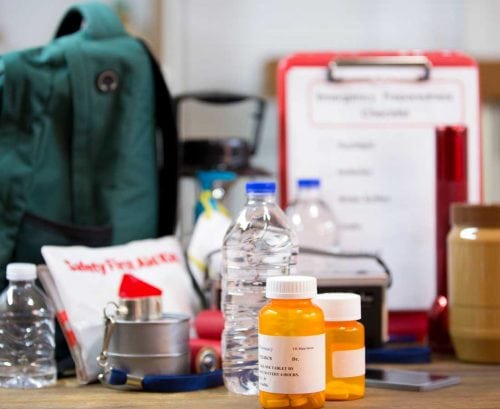
Being prepared ahead of time for a natural disaster or emergency is your best insurance to get you and your family through difficult situations. This means having a fully stocked emergency or disaster kit you can rely on to keep you going when the unexpected happens.
In the event of an emergency, it is a good idea to have enough food and water on hand to last for two weeks. This means having a good store of food and water on hand at all times.
Together with a well-stocked first aid kit, including masks, gloves, disinfectant and torch – and practising good hygiene – being prepared with food and water are the best things you can do to stay well during a natural disaster.
How to plan and shop for an emergency kit
In my experience as a public health nutritionist, I find that most people are keen to get emergency food stores, but not sure of what or how much they need. Living on baked beans may be fine for a short while, but not much fun for any length of time. We need to include a variety of foods, particularly ones with good nutritional value. It should also be enjoyable and as close to our normal way of eating as possible.
Tips for planning and shopping
Here are some tips on preparing your emergency supplies:
Don’t get put off by the size of your shopping list. Purchasing a little at a time will spread the expense. Remember that you won’t end up wasting anything if you practice stock rotation carefully.
- Choose familiar foods as much as possible – they help lift morale. Look at what you normally eat and enjoy, and buy extra of that.
- Choose foods that will last without refrigeration for at least six months – canned, dried and preserved or non-perishable foods.
- Ensure you have some foods that are ready-to-eat or only need to be heated up without adding water. This will ensure you are prepared in case of fuel and water shortages.
- If you are not a cook, buy ready-made and instant foods as much as possible. If you enjoy cooking, however, choose basic ingredients such as flour, yeast, legumes, dried vegetables, nuts etc.
- When buying cans, don’t automatically buy the biggest sizes thinking this is better value. Buy larger cans only if you are catering for a big group of people; you don’t want leftovers if you don’t have reliable refrigeration.
- Assume you will be caring for sick people and ensure you have the foods (clear soups, juices, jelly crystals etc) and basic first aid supplies you will need.
- Buy the least perishable and most essential items first.
- Keep up your normal pantry and fridge stocks of perishable foods like meats, cheese, bacon, fruit and vegetables.
- Remember to buy multivitamin supplements. These may be useful if people are not eating their usual varied diet.
- Don’t forget food for your pets. It should also be non-perishable with a long shelf life and stored in cool, dark conditions.
- Remember to include cleaning and personal hygiene products on your list.
- Ensure you have a well-stocked first aid kit – check with your doctor or pharmacist if unsure what you will need. If you are on prescription medicines (,eg, for blood pressure), remember to get extra of these.
- Plant a garden – this will assist your self-sufficiency. Fresh vegetables and herbs are especially useful to add interest and variety. They also provide vitamins, minerals and antioxidants to help keep you well. What to plant depends on your local conditions and the season. Crops that produce for a long time, require little attention, or keep well in the ground are good choices. Examples include root vegetables, silver beet, rhubarb, parsley and mint.
- Invest in a bread maker and a yoghurt maker – these will come into their own in a pandemic or other natural disaster.
Food checklist
The following is a list of the basic foods in my emergency kit. To complement these, I keep good stores in my pantry of condiments I use often like soy sauce and sweet chilli sauce. I also make sure I have good supplies of longer-lasting refrigerator items such as cheese and bacon. Quantities are what a family of four would need for two weeks.
- 10kg flour
- 6 packets breakfast cereal or 3kg rolled oats
- 3kg pasta (3 meals per week)
- 6 x 100g packs dried vegetables, e.g. peas and beans
- 8 x 400g cans legumes, e.g. chickpeas
- 14 x 800g cans fruit
- 7 x 400g cans tomato
- 4 x 400g cans tuna and salmon
- 14 packets crackers
- 2kg dried fruit
- yeast if breadmaking
- 200g stock cubes/powder
- 3kg milk powder
- 1.5kg sugar
- 2kg rice (4 meals per week)
- 8 x 400g cans baked beans/chilli beans
- 1-2kg lentils
- 7 x 400g cans sweet corn
- 4 x 400g cans beetroot and/or asparagus
- 7 packets old-fashioned dried soup mix
- 4 jars assorted jam/peanut butter/Vegemite/honey
- 2kg nuts/popcorn
- 7 pkts yoghurt mix (if have yoghurt maker)
- 10-12 packets powdered fruit drink with vitamin C
If disaster strikes: How to use your emergency stores
All meals should provide us with both energy (kilojoules/calories) and nutrients (components of food that keep us well). In a pandemic or other disaster situation, this is even more important, since staying well is our prime goal.
Although it may not always be possible, we should aim for at least one nutritionally balanced meal a day. We should also aim for the recommended number of serves of breads and cereals (6 or more), fruit and vegetables (5+), milk and milk products (2 serves) and protein foods (1 serve) so that all our nutrient needs are met. Following is a menu for a day using emergency food supplies that meets the number of recommended serves.
Breakfast
- Porridge/other cereal
- Canned fruit
- Milk
- Piece of toast with jam
Lunch
- Cheese sandwich
- 6 dates
Dinner
- Creamy pasta with tuna and corn
- Peas and carrots
- Canned fruit and yoghurt
Snack
- Popcorn and fruit drink
Simple meals made using this formula
- Rice with canned salmon or tuna with canned tomato and beans
- Rice with chilli beans and peas (add some bacon or chorizo sausage if you have it)
- Instant noodles cooked with dried peas and corn and served with tuna
- Rice with baked beans
- Fried rice with nuts, peas and corn
- Bean salad using 4 bean mix, canned whole kernel corn and cooked green beans
- Pasta cooked with packet soup mix, with bacon and dried vegetables added
- Nachos – corn chips with chilli beans, cheese and gherkins
- Rice with salami, cheese and pineapple
- Lentil soup with crackers or bread and cheese
Simple meal ideas
When combining ingredients to make meals, a good rule of thumb is to start with a carbohydrate item, add a protein item, then a vegetable or fruit.
CARBOHYDRATE: Pasta, Rice, Potatoes, Couscous, Polenta
plus PROTEIN: Canned fish, Canned meat, Bacon, Cheese, Nuts and Seeds, Lentils, Chickpeas, Red kidney beans etc
plus VEGETABLES AND FRUIT: Canned tomato, Canned corn, Canned mushrooms, Dried peas and beans, Canned pineapple, Dried fruit
Recipes using emergency stores
In an emergency situation, you may be at home in relative isolation, simply because schools and workplaces are closed. You may be perfectly well, and therefore able to spend more time than usual on food preparation. If this is the case, use the opportunity to practice new recipes and to inspire the rest of the family, particularly the children, about cooking. Here are two recipes; try them out and get a head start on knowing how to cook in difficult times. (They are great recipes for normal conditions as well.)
Lentil bolognese
This is so like the meat version that many people don’t even realise it is a vegetarian dish.
- 1 cup brown lentils
- 3 cups water
- 2 teaspoons oil
- 1 medium onion, chopped
- 1 teaspoon crushed garlic
- 220g can mushrooms (optional)
- 1 1/2 cups pasta sauce or tomato soup concentrate
- teaspoons sugar
- 1 teaspoon dried basil
- chilli flakes/powder to taste
- salt and pepper to taste
Put lentils and water in a saucepan. Bring to the boil, reduce heat and simmer for 30-40 minutes or until tender; drain.
Heat oil in a large saucepan, add onion and garlic and cook until transparent. Add remaining ingredients and simmer for 10-15 minutes.
Season to taste and serve over pasta. Top with grated parmesan cheese if you have it.
Serves 4
Points to note
- You may need more water to cook your lentils: add more if they are looking dry.
- If you do not have fresh onion, add dried onion flakes to sauce with garlic and remaining ingredients (3 Tb = 1 medium onion). Alternatively, leave out altogether.
- If power is off or fuel is scarce, use red/orange lentils; they take less time to cook.
- Soaking lentils in water prior to cooking will shorten cooking time.
Fruit crumble
It may seem frivolous to have dessert when times are difficult, but if you have the ingredients and the time, it can be a great morale booster. Keeping up morale may be one of our biggest challenges should a disaster strike!
- 3 cups canned, stewed or bottled fruit
Topping
- 2/3 cup rolled oats
- 2/3 cup wholemeal flour
- cinnamon 1 teaspoon
- 1/4 cup sugar
- 1/4 cup walnuts or other nuts
- 4 tablespoons milk
Place all topping ingredients in a bowl, adding the milk last. Stir until mixed. The mixture should bind together when pressed but should not be sticky or wet.
Place fruit in ovenproof baking dish, cover with topping and bake at 180ºC for about 20 minutes, or until topping looks browned and crisp.
Serve with custard or yoghurt.
Serves 4
Points to note
- If using canned fruit, drain most of the liquid.
- Add the milk gradually as the mixture should still look crumbly; if the mixture is sticky the topping will be tough when cooked.
- Leave out the nuts if you do not have or don’t like.
- Dried fruit can be added to the fruit for variety; add prunes, dates, figs, raisins or sultanas.
Water: How much do you need?
Storing enough water is essential when preparing a disaster. We can survive for weeks without food but only for a few days without water. Good hygiene and keeping well hydrated are critical these are virtually impossible when water is limited. Experts recommend laying in a two-week supply of water, storing it in clean containers, and changing it every six months or so. They recommend 4-5 litres of water per person per day, which works out to be about 70 litres per person for a two-week period. To help you visualise this, an average-sized rubbish bin holds 72 litres, which means one bin full per person for two weeks.
Bronwen King is a nutritionist and author of the book Survive Bird Flu and Other Disasters.
www.healthyfood.com










